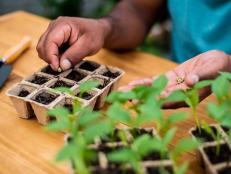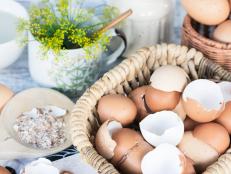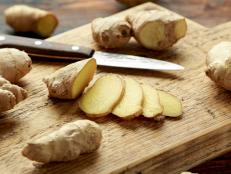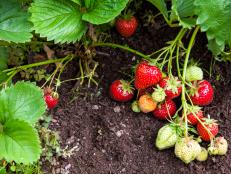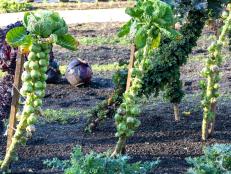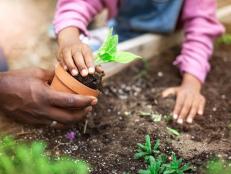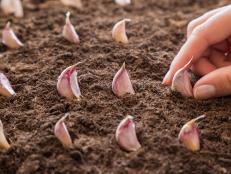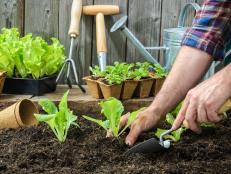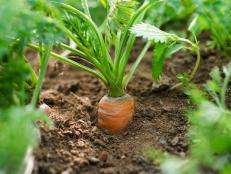How to Plant Potatoes
With a little knowledge and preparation, you can plant your very own potatoes in your home or community garden.

Mint Images RF/Getty
Potatoes are vegetables many of us may take for granted. After all, “meat and potatoes” is usually a term used to describe basic yet fundamental foods. However, when you look at the over 2,000 varieties of potatoes grown in the spud’s native home of Peru, you quickly realize that this hearty vegetable can be much more exciting than the few varieties you find at the supermarket. In North America, we also have a wide variety of heirloom potatoes that boast a dizzying array of colors, flavors and textures, and you can plant all of them yourself. What’s best is that potatoes are just as hardy in a garden as they are hearty in a soup or stew, meaning that even a novice gardener can get a handsome crop of spuds. So, if you’re a potato fanatic or simply wanting some variety in your veggie garden, read below to learn how to plant potatoes yourself.
Best Conditions for Planting Potatoes
Planting potatoes requires a little bit of preparation, but they’re nothing to get anxious about. As long as tubers have access to decent soil, sun and water, you’re sure to get a good crop. The first thing you need to know about planting them is that they won’t start growing until the soil temperature reaches 45 degrees Fahrenheit. You can typically start to plant potatoes in the spring as soon as the soil is workable (i.e. not frozen solid). However, they won’t start growing until the soil warms up.
Potatoes like lightly packed, loose soil that is well-drained and slightly acidic (pH of five to seven). If you’re not too sure about how well your soil drains, make sure to put rocks or gravel down first before adding soil and be careful not to pack your soil too tightly. Your soil should be moist but avoid over watering. Really wet soil can cause the potatoes to rot.
Potatoes love full sun, so make sure to plant them in an open area where nothing is blocking the rays. Potatoes are pretty resilient, but you should still protect them from frost with insulation, such as mulch. If you plan to plant potatoes early in the spring, pay attention to the weather forecast and make sure to cover up your spuds if the weather is going to drop.
You can also opt to plant your potatoes as late as early June and still be able to harvest later in the winter, although you will still need to pay attention to frosts and protect your spuds. If you get hooked on growing, remember that soil they’re planted in needs to be rotated. This means that you should not grow potatoes in the same spot for at least two to three years to let the soil regain its nutrients.

© Jackie Bale/Getty
Prepping Your Potatoes for Planting
The potatoes you use to plant are referred to as seed potatoes. There’s nothing that differentiates seed potatoes from eating potatoes except for a bit of preparation. Any type of potato can be a suitable seed potato, although you will want to use a natural potato, like what you get at a farmer’s market. While supermarket varieties may yield a satisfactory crop, those types of potatoes may have been genetically modified to prevent replanting.
At least a week before you intend to plant your potatoes, leave out your whole potatoes somewhere warm (ideally 60 to 70 degrees Fahrenheit). This can be in your kitchen or on your windowsill. The reason for this is that you want your potatoes to start sprouting, and you’ll notice little buds forming on the eyes -- the little pinpoints or divots that cover a potato.
Once your potato sprouts, take a sharp knife and carve little chunks of potatoes about two square inches thick. Each little chunk should have at least one eye or bud (two are better, but no more than that). If a potato is smaller than a golf ball, it’s okay to plant it whole. After you’ve cut your seed potatoes into smaller sizes, let them dry out for a couple of days. The cut parts of your seed potato pieces will form a hard skin, which will help prevent the potatoes from rotting. Don’t skip this step, especially if it’s your first time planting spuds.
How to Plant Potatoes
For thousands of years, our ancestors have planted potatoes in neat rows directly in the ground, and that’s still the most recommended method for planting potatoes. However, you don’t need to grow rows upon rows of these tubers if you have limited space (or don’t want a lot of potatoes). Planting potatoes directly in the ground, however, is recommended because potato plants need room to expand their roots and grow in size. While potted potato plants can work out, you may not get the same yield or size of potatoes.
Whether you’re planting a row of potatoes or a single plant, first start by digging a six- to eight-inch hole or trench in your garden bed. Make sure that the soil is tilled and loose, as this will help the potatoes grow much more easily. Place a potato chunk (or whole small potato) in the hole with the eyes facing up. If you’re planting a row of potatoes, space them out about 12 to 15 inches apart. If you’re planting multiple rows, space each row about three feet apart from each other. Cover your seed potatoes with no more than four inches of soil to begin with. As you see the plants growing, add more soil as needed.

Westend61/Getty
Caring for Your Potato Plants
Once you have planted your potatoes, make sure they get between one to two inches of water each week. As a general rule, it’s good to have a rain gauge in your yard so you can keep track of how much rain your plants are getting and adjust the amount and frequency of water you give all your plants.
Once your potato plants start to flower, you need to be on top of watering and make sure that the soil is moist. This is a crucial time when the plant is creating potatoes underground and needs sunlight and adequate water for the potatoes to form and grow. Once the flowers turn yellow and the plant starts looking like it’s dying, don’t freak out! Your potatoes are still alive and well underground, but need time to cure to develop their flavors and textures. Do not water your plants during this time.
Harvesting Your Potatoes
You can harvest the potatoes you planted in different stages depending on how you want to enjoy them. Two to three weeks after your plants have stopped flowering, you’re ready to harvest baby potatoes, which are small, soft and tender. Carefully dig around the base of your plant and pick off the larger baby potatoes. Leave the small, marble-sized (and smaller) ones to grow a little bit more. Just take what you need to eat. You can leave the rest in the ground to continue growing. Be sure to cook them the same day.
Two to three weeks after the potato plant dies and dries out, you’re ready to dig up your mature taters. Use a garden fork to gently dig around your potato plants. Tap off any excess dirt. As with the baby potatoes, let the smaller potatoes mature a little bit longer if you wish. If you live in a dry place, leave the potatoes out on the ground for a couple of days. Alternatively, you can leave them inside your home, preferably under a fan. This drying process helps the potato skins to toughen up a little, which will help your potatoes last longer when you store them.
Related Content:
























